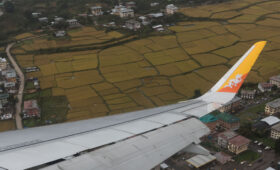Phrumsengla National Park: A Wilderness Journey into the Heart of Bhutan
At the heart of the eastern Himalayas, in the remote kingdom of Bhutan, with rolling Cloud Mountains, Phrumsengla National Park (PNP) is a jewel within the protected areas system of Bhutan.
Established in 1998, with an area of 905 km’ and with huge expanses of some of the last remaining strands of cool temperate broad leaved forests and old fir growth in the entire Himalayas, Phrumsengla National Park is home to some of the world’s most endangered flora and fauna.

Location and Topography
Thrumshingla National Park or Phrumsengla National Park spans across four districts—Bumthang, Mongar, Lhuentse, and Zhemgang—offering a breathtaking journey through the diverse landscapes of Eastern Bhutan. As you travel from the warm southern valleys at around 800 meters above sea level to the rugged alpine regions rising above 4,500 meters in the north, you’ll witness an extraordinary transition in terrain and vegetation.

Climate
With wide variation of altitudinal ranges, Phrumsengla National Park experiences wide range of temperatures as well. The northern part of the park experiences temperatures ranging from a minimum of -21° C to a maximum of 13° C and the south-eastern part has minimum of 8° C and maximum of 28°
The annual average rainfall in the northern part is 700 mm and the lower elevation receives up to 1500 mm.
Biodiversity
Ecological Zones by Elevation:
-
- Subtropical Zone: 150–1,000 m
- Warm Temperate Broad-Leaved Forest: 1,000–2,000 m
- Cool Temperate Broad-Leaved Forest: 2,000–2,900 m
- Temperate Coniferous Forest: 2,100–3,000 m
- Subalpine Conifer Zone: 2,600–4,200 m
- Alpine Zone: above 4,000 m
The riparian ecosystem vertically links all ecological zones from alpine snows to swollen subtropical rivers.
More than 622 plant species occur in Thrumshingla National Park, comprising of 152 medicinal plants and 21 species endemic to Bhutan. Rhododendron flowers add beauty to pristine fir forests at the higher elevations.
Phrumsengla National Park is home to 69 species of mammals. The Royal Bengal Tiger (Panthera tigris) has been recorded as high as 2950 meters above sea level. The Red Panda (Ailurus fulgens) are frequently sighted along

If you’re driving from Bumthang towards Mongar, you’re in for one of Bhutan’s most breathtaking natural experiences. About 500 meters after Leri Zam, as you enter the Ura–Mongar highway, you cross into Phrumsengla National Park—a vast, ecologically rich protected area stretching across four districts: Bumthang, Lhuentse, Mongar, and Zhemgang.
Phrumsengla National Park or Thrumshingla national park
Is the correct name Thrumshingla or Phrumsengla? Both refer to the same mountain pass; however, the official designation has been updated to Phrumsengla to more accurately reflect its local etymology and significance. In the native tongue, “Phrum” denotes cheese, symbolizing its white color, “Seng” means tree, and “La” translates to mountain pass. Locals refer to it as Phrumsengla because the pass is often adorned with snow that resembles white cheese delicately resting upon the trees and surrounding mountains—a striking and enduring natural feature.
Phrumsengla National Park: A variety of Experiences
-
Highway to the Sky
Your journey through Phrumsengla National Park on Bhutan’s National Highway will pass through six of the park’s seven ecological zones, in just 120 kilometers. If you’re driving from Bumthang towards Mongar, you’re in for one of Bhutan’s most breathtaking natural experiences. About 500 meters after you enter the Ura–Mongar highway from Leri Zam, as , you cross into Phrumsengla National Park—a vast, ecologically rich protected area stretching across four districts: Bumthang, Lhuentse, Mongar, and Zhemgang.
Phrumsengla or Thrumshingla Pass
At 3,750 meters, this is the highest point on the highway. On clear days, it offers views of Gangkhar Puensum, Bhutan’s highest peak at 7,541 meters.
3. Rhododendron Garden Trek

From Thrumshingla Pass, a short trail (under 2 km) descends into a subalpine forest bursting with rhododendrons—nearly 49% of Bhutan’s species. As an in-situ garden, the flowers grow wild in their native habitat, not curated. The trail offers a fairytale-like woodland experience—silent, colorful, and deeply immersive.


4. Cliffs, Waterfalls, and Winding Roads
Beyond the pass, the road zigzags down into the subtropics. Along the way, Namling Waterfall plunges dramatically off the cliffs—a striking stop on your descent.
5. Birds Galore
Phrumsengla is a paradise for birders, boasting over 360 bird species, including several that are rare, endangered, or endemic. Ask park officials for the best birdwatching areas.

6. Wildlife in Abundance
Wildlife diversity mirrors the park’s varied terrain. You may encounter:
- Leopards
- Himalayan black bears
- Muntjacs
- Langurs
- Red pandas
- Tigers
Each ecological zone supports its own unique fauna, from highland herbivores to jungle predators.
7. Trekking and Cultural Routes
Phrumsengla’s trails are not just scenic—they’re cultural corridors. Some lead to ancient temples and remote villages, while others wind quietly through pristine forests. Park staff can help match treks to your interests—whether it’s culture, wildlife, or solitude you seek.
8. A Park for People
More than a wildlife sanctuary, the park is home to 11,286 people across 1,165 households. These communities have coexisted with nature for generations and are key to its preservation.
9. Ethnic and Cultural Diversity
The park’s surrounding communities include:
- Sharchops
- Bumthaps
- Khengpas
- Kurtoeps
Each group has its own dialect and traditions. In Lhuentse Dzongkhag, for example, many speak a dialect known as “Choe cha nga cha”—a living link to Bhutan’s rich linguistic heritage.

Phrumsengla National Park is not just a protected area but a living tapestry of Bhutan’s ecological and cultural richness. Whether it’s the vibrant colors of blooming rhododendrons, the haunting call of rare pheasants, or the winding descent from snow-capped ridges to lush subtropics, the park offers an unforgettable journey through nature’s full spectrum. It is a place where conservation and community co-exist, reminding visitors of the delicate balance that sustains Bhutan’s wilderness.





